WARNING: This article will drastically improve your outreach skills.
Tim, your post about outreach had a massive impact on the amount of links we were getting. It was something like 7-10 links for every 100 emails sent. Now its like 7-10 links for every 50 (or so) emails sent! People’s responses were totally different too (in a good way). I’ve since hired someone to do email outreach completely based on your post. Works b.e.a.u.tifully! (I hope you read that in Jim Carry’s voice) 🙂
The profession of an “online marketer” requires us to do lot of so-called “outreach.”
We reach out to let others know about our content, ask for a backlink or simply make a connection.
But there’s one more group of people who do lots of “outreach.”
SPAMmers.
So where’s the red line between the two? And which camp would you put yourself into?
Trivia: Outreach or Spam?
Here’s an email I got the other day:
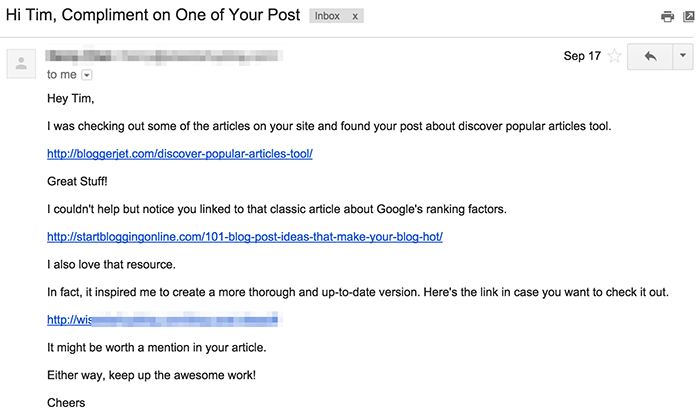
What would you call it: Outreach or SPAM?
Please leave your vote before you read any further. It would be fun if there are two opinions to it.
As for me, I deleted it without reading. It’s not that hard to notice a template:
- Hey, I just found your post: http://post1
- It links to this post: http://post2
- I have a similar post: http://post3
- Please link to me too.
Yeah, sure… *Delete*
“Outreach” is not “Broadcasting”
You just published a new article on your blog and now you’re going to send a mass email to 100+ top people in your niche with an excuse: “I saw you tweeted a similar post.”
I’m sorry to say this, but your article is not welcome in their inbox.
Otherwise, they would probably already be signed up to your email list.
And besides, it’s just disrespectful to mass-email top people in your niche with some generic “outreach template.”
The more famous a person is, the more of these outreach templates he gets in his inbox daily.
That’s why you should divide your list of prospects into four groups and treat each group differently:
1. Sharks
These are the people with a huge audience and notable achievements (think Gary Vaynerchuk, Malcolm Gladwell, Tim Ferriss, etc.).
They don’t have time to read emails from strangers, so your only chance to reach them is by a personal introduction or by doing something really creative and outstanding.
It will take a ton of work (and probably luck) to get on their radar, but these people can send hundreds of customers your way with just a single tweet. So the outcome is well worth the effort.
2. Big Fish
These people are not as famous as the Sharks, but their audience is big enough to make an impact on your own business (think Noah Kagan, Nathan Barry, Glen Allsopp, etc.).
There’s a good chance to reach them with a nice personal email, but never with a template.
Asking Big Fish for tweets and links is unproductive (and silly), you will get much more value by asking them to critique your work or validate your ideas.
And if what you’re doing is worth attention, they will tweet it and link to it anyways.
3. Small fish
These people don’t have a big audience yet. Their websites are only starting to get traction and they are actively promoting themselves by contributing to niche communities, writing guest articles and participating in all sorts of events.
They are your ideal outreach targets.
4. Spawn
They are just starting out in your industry and they will most likely reply to your outreach email even if it’s 100% templated.
But it doesn’t really make much sense to reach out to them. They don’t have any traffic to send your way, and a link from their website is hardly worth anything because it’s so new.
As you have probably guessed, you should focus your outreach efforts on two groups: “Small fish” and “Big fish.”
And what follows is the process that Ahrefs’ marketing team uses to reach out to these people and get replies like this one:

Prefer video? You got it.
https://www.youtube.com/watch?v=nAIWG8883uo
1. Use the correct email address
This first tip may seem like a total no-brainer, but give me a chance to explain.
Too many people rely on some automated tools to scrape (or sometimes even guess) their outreach prospects’ email addresses instead of investing a bit of time to research a person manually and find his actual email.
For example, my own email address is listed on our team page for everyone to see: [email protected]
But some people prefer to send their emails to a non-existent [email protected], which are picked up by our catchall:

I ignore these emails in 99% of cases.
The fact that a person didn’t bother to find my real email tells me he’s not that interested in getting in touch with me. So I’m not interested in replying either.
If you need a good process of finding email addresses, check out our recent article: “8 Actionable Ways To Find Anyone’s Email Address.”
2. Think what’s in it for them
You want a link, you want a tweet, you want to be featured in front of their audience. But what will THEY get out of it?
If you don’t provide value and only ask them to do something for you, your success rate is going to be extremely low.
Here’s how you can make your outreach about them:
Show them something new & valuable
If you have something truly unique and outstanding, influencers might appreciate a heads up.
And besides, people with large audience need a constant flow of awesome content to cater to their fans, so they will be grateful if you show them something of value.
But let’s face it, Sharks and Big Fish are super hard to impress. The stuff that seems unique and outstanding to you might easily be old-school for them.
Research your topic well before contacting top people in your field and be realistic about the novelty and uniqueness of your offering.
Once you define what makes your content unique, make sure to clearly articulate it in your email so you can pique their interest.
Here’s an example of my own outreach email:

I didn’t just say, “Check out my amazing research of guest blogging.” I actually explained what I did there and shared a few quick takeaways from my article.
This helps the recipient evaluate whether your content is worth checking out and reduces the chances you’ll waste their time on an article they view as only “average.”
Feature them
It’s incredibly hard to resist checking out a piece of content when you know it talks about you. So why not use this to your advantage?
Remember that a person’s name is, to that person, the sweetest and most important sound in any language
If you see a way to feature a well-known person (or their business) in your article, do it and let them know about it.
This can be anything really:
- A quote from their article, podcast or talk
- Some feedback about the things you’ve learned from them
- A positive experience with their product, service or company
If you make them look good, they’ll want to tell their audience about it:

3. Only use your best work
We have 300+ articles on the Ahrefs Blog and most of them are very good, but we only do outreach for a handful of the very best ones (most of them are featured on our blog homepage).
This aligns with the tip that I just shared above: “Show them something new & cool.”
You only have one chance to make a good first impression on the top people in your industry. Do you really want to blow it by sending them your “average” article? I hope not.
But the reality is, most people think every article they publish is a masterpiece. That’s why influencers’ mailboxes are flooded with content that’s anything but special.
So how do you make sure your outstanding article won’t get buried in that pile of “average”?
Provide social proof
Is there anything about your article that would prove you’re not the only person who thinks it’s cool?
- Did it generate 100+ comments?
- Did it get tons of upvotes on Reddit?
- Did someone famous tweet it?
- Did you get cited by authority website in your niche?
Anything along these lines will make your outreach email stand out massively.
Take a look at my example:
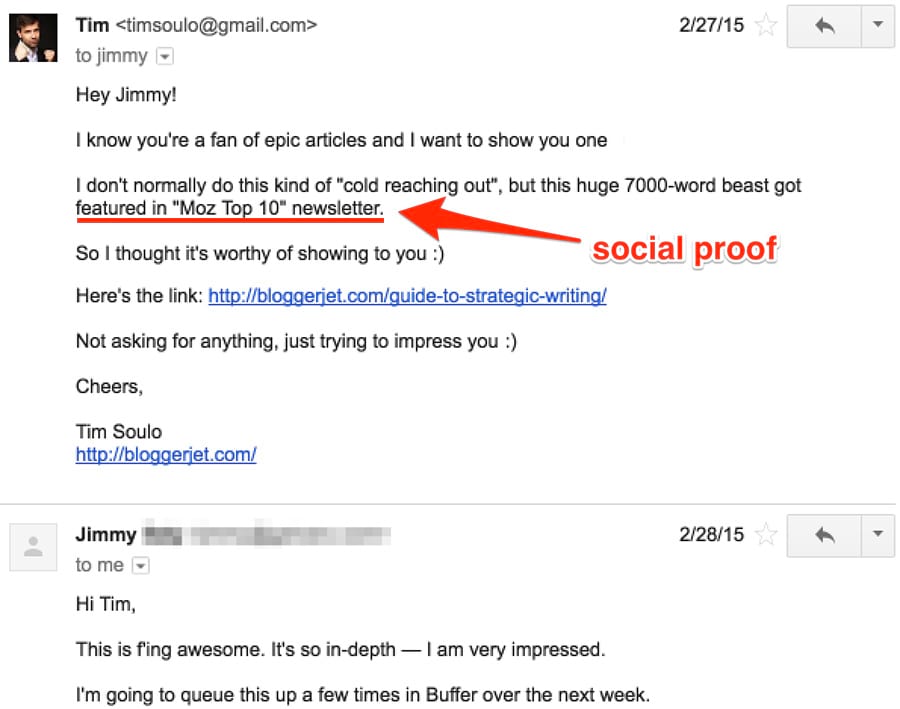
Try to get some initial traction with your article and then use it as your social proof when reaching out to people.
4. Re-think your outreach excuse
Here are the 3 most common excuses that I see people use for outreach:
You tweeted this post, and I wrote a similar one…
You published this post, and I wrote a similar one…
You linked to this post, and I wrote a similar one…
Why would anyone want to check out a post that’s similar to what they just read?
“Similar article” is a very poor excuse, and it shows you didn’t study the person you’re reaching out to.
A decent excuse would look like this:
You tweeted this post, and I thought you’d be interested in checking out a different opinion on that topic. In a nutshell it’s all about XXX and you can read about it here…
You wrote this post, but you didn’t mention one very important aspect. I’m talking about XXX and I’ve explained it in this article…
You linked to this post, and I thought I should show you a much better resource on that subject. It’s better because XXX…
I’m pretty sure the difference is clear.
But to come up with an excuse like that, you’ll have to actually skim through the post they wrote/linked to/tweeted and figure out how your own article is different from it.
Most people never bother to study their outreach prospects, and this is how they find themselves featured as bad outreach examples:
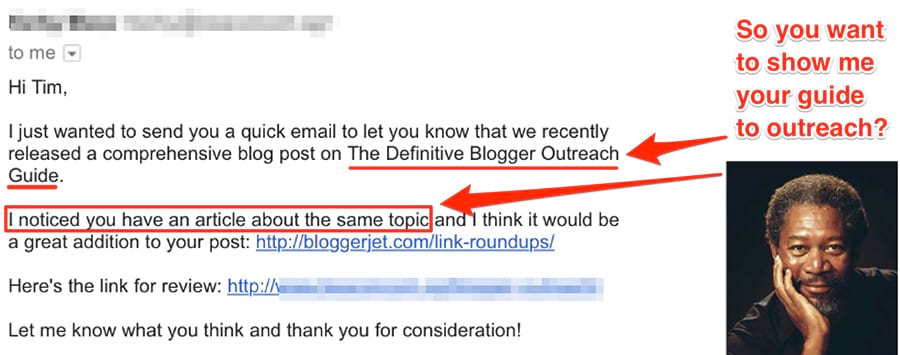
Reading every article before you reach out and figuring a proper excuse for outreach might sound like a ton of work.
But that’s only the case when your article isn’t unique enough.
Let me explain what I mean with an example.
In our recent article, we called out SEO professionals for popularising a wrong definition for the term “long tail keywords” and shared the right one.
Guess what kind of excuse we’re using in our outreach template for that article?
Hey %First Name%,
I noticed that you’ve mentioned a concept of “long tail keywords” in your recent post about {post topic}.
Here at Ahrefs we believe that the definition of the term “long tail keywords” in 2017 needs to be revisited. As well as the actual strategy of getting traffic from them.
Please check out our recent post for more details: https://ahrefs.com/blog/long-tail-keywords/
Given that you have a lot of experience in the SEO field, it would be interesting to know what you think about it.
Thanks in advance!
In other words, if your content is offering something really unique, it won’t be too hard to craft a good outreach excuse.
5. Throw away your outreach templates
As you can probably tell by now, there’s no way to scale your outreach while maintaining the quality.
It’s too easy for your recipients to see when your email is automated and therefore ignore it.
I have no hard feelings when I throw automated outreach emails into the trash can. I know hundreds of other people have received the exact same email and most of them didn’t bother to reply.
Don’t get me wrong, I’m not advocating against templates—there’s no way to email 100+ people about the same thing and write your email from scratch every time.
I’m only trying to say you should spend more time crafting a template that doesn’t look like one and leave some room for personalization.
Here are a few tips to consider:
Don’t use generic subject lines
Let’s go back to the subject of the email I shared above.
Subject: Hi Tim, Compliment on one of your posts
Doesn’t this look sleazy right off the bat? I didn’t open the email yet, but I’m already sceptical.
My favourite approach to email subjects is to keep them short and not too obvious.
Example:
Subject: ahrefs link building advice
You can clearly tell that this subject has something to do with link building and Ahrefs.
But what exactly?
- Is there some problem with their backlink profile?
- Am I offering them some link building advice?
- Am I asking them for link building advice?
You’ll never know until you open the email and learn that I am asking you to check out our amazing Noob-Friendly Guide To Link Building.
Avoid patterns
When people use outreach automation software, they often follow an easy-to-distinguish pattern.
It usually goes like this:
Hey %First_Name%,
I just came across your article: %URL_of_their_article%
It’s an amazing piece of content and I learned a lot from it.
I noticed that you linked to this post: %URL_where_they_link_to%
It’s a great post, but I wrote an even better article on that same topic.
Check it out here: %URL_of_my_article%
I hope you can add a link to my post in your article or at least tweet it.
Thanks!
Whenever I see an email structured in a similar manner, I realize that there’s some automation in place, which gives me the moral right to ignore it.
Here’s an example of a template we use at Ahrefs:
Hey %First_Name%,
I just stumbled upon your article about {what their article is about}
{Try to say something smart about their article: feedback, compliments, jokes, etc}
I figured you might be interested in checking out our (Ahrefs) “Noob Guide” to link building:
https://ahrefs.com/blog/link-building/
Obviously you’re not a noob, and it is unlikely that you’ll find anything groundbreaking there.
But I’m pretty sure that you get some “noob” questions about link building now and then, so perhaps you’ll find our guide good enough to share it with these people, instead of trying to explain everything on your own.
In this guide we have featured all the major link building strategies and even did an industry survey to figure out which were the most popular and most effective ones.
Oh, and if you think our guide is lacking something - we’ll be happy to revise it.
So yeah, looking forward to your feedback.
And thanks in advance!
-Tim
That is still a template, but it leaves room for a lot of personalization and it doesn’t follow any obvious pattern.
Other than this one:
- Mention which article of theirs made you reach out.
- Give feedback about that article (if any).
- Plug your own article.
- Explain what makes your article unique and why they should care to check it out.
- Ask for feedback.
If you follow this pattern, you will create a unique outreach template for every new piece of content.
And if you ask me, I wouldn’t dare to delete an outreach email like this one
Quit stupid flattery
Everyone loves to be praised, right? That is why every outreach template that you’ll find will start with a few words of praise.
And it’s usually ugly as hell:
I just read your article and it is very cool.
I’m a long-time reader of your blog and I think your content is totally amazing.
Thanks for posting your outstanding article about %topic%, I’ve learned a lot from it.
You should never use this kind of templated flattery in your outreach emails.
Either say something meaningful, or don’t say anything.
Here are some good examples:
I loved your advice on doing XXX. I’m totally going to implement it this month.
Your story of XXX is totally inspiring. I’ve just shared it with couple of my friends.
Your take on XXX totally rocks! I never thought of it this way!
That “XXX” part was highlighted for a reason. By adding context, you show them that your flattery is not templated, but you actually took time to study their work.
Nick Churick is pretty good at that:

6. Show them you know them
If you take time to dig a little to learn more about the person you’re reaching out to, your chances of getting a response from them will go through the roof.
I mean, if you cared to spend your time learning about me and you showed it in your outreach email, I’d feel like a total ass if I didn’t reply.
Look again at the email example I shared earlier:
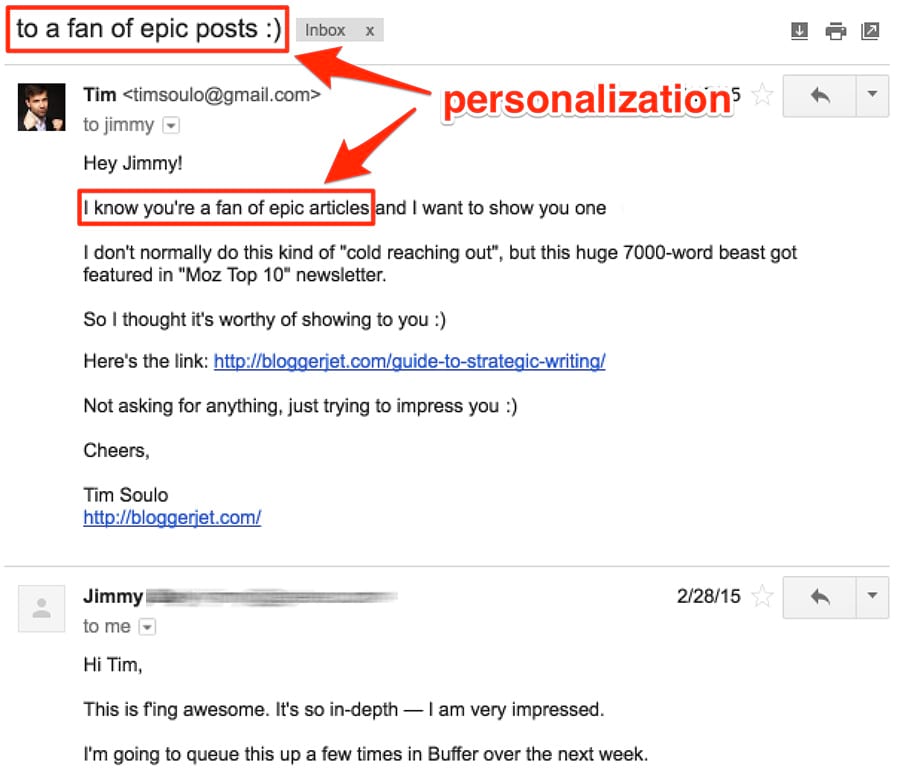
I knew that Jimmy was a fan of epic guides, because he recently published an “epic guide to email marketing.” And this allowed me to send him a personalized outreach email.
7. Timing is your friend
Just because someone wrote an article about something a few years ago, it doesn’t mean they still care about it today.
And there’s almost no chance you can get them to update that old article and link to you.
But the opposite is also true.
If the article was published just yesterday, its author is an easy outreach target.
Here’s a screenshot that shows how Brian Dean updated his newly published article with 22 more tools, shortly after it was posted to Inbound.org:

That’s because he got a ton of outreach emails with tool suggestions immediately after publishing his article.
Do you think you can make him add your tool to the list if you email him now?
The chances are very slim.
He has already moved on to something else and won’t get back to that article anytime soon.
8. Ask wisely
Asking for favours is an art. But most people never give it a second thought and act as if everyone owes them something.
Here are a couple of rules we follow at Ahrefs when reaching out to people:
Don’t ask for tweets
It’s obvious, that you’re reaching out because you want some exposure for your piece. You know it and your recipient knows it too.
But as soon as you ask for it directly, two things happen:
- Your email is no longer about giving value to them. It’s about asking for a favour to you.
- If they don’t want to tweet your article, you’re putting them in a difficult situation.
I hate to tell people, “No, I won’t tweet your article.” I’d rather not reply their email at all.
But if I like your content, I will tweet it, even if you didn’t ask me to:
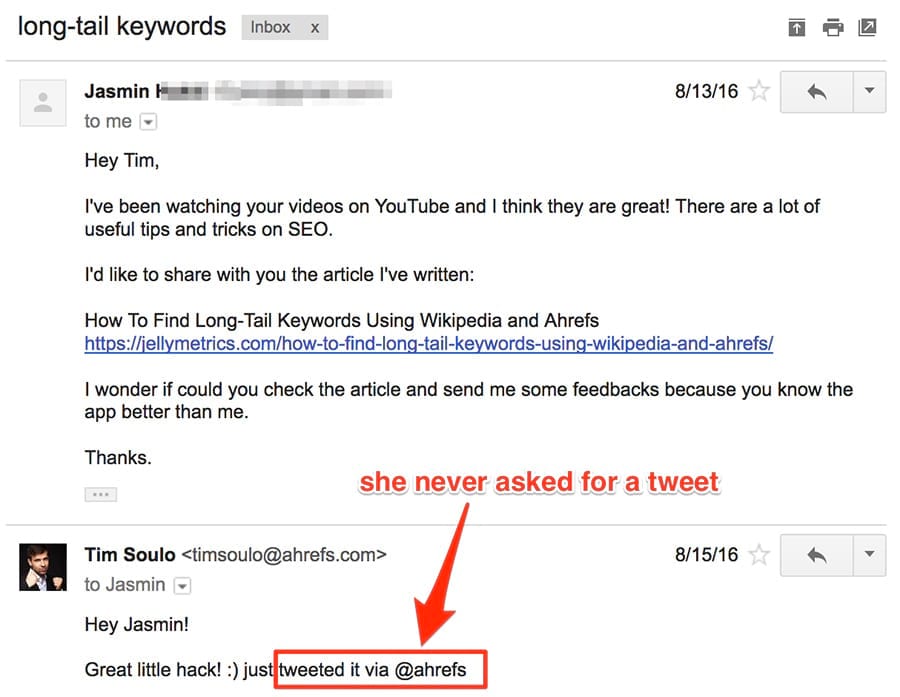
Ask for links
Unlike with tweets, people do require a soft nudge if you want them to link to you.
But you have to make sure you’re giving them an easy way out, in case they don’t want to do it.
Just frame your request like this:
Let me know what you think about the post. Maybe it’s worth mentioning in your article (or in future ones)?
Would love to know your opinion on that article. And if you’ll find it useful, please consider linking to it from that post of yours, or perhaps mentioning it in your future writing.
You’re still clearly asking for a link, but you’re making your request easy to ignore, if a person doesn’t want to do it.
9. Follow up, once
Quite often people don’t respond, not because they don’t want to but because they forgot to.
This can be solved with a short polite follow up:
Hey %First_Name%,
Just a quick follow up in case you’ve missed my email.
If you’re short on time right now - no worries. I won’t bug you about it again.
Thanks.
-Tim
That’s it.
Please don’t send more follow ups.
Seriously:



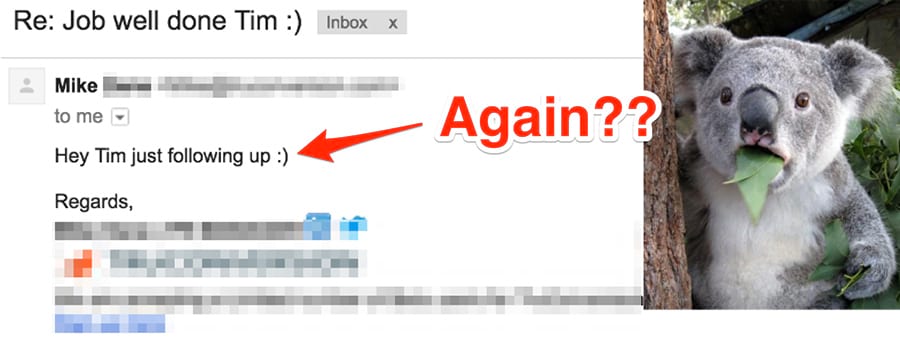
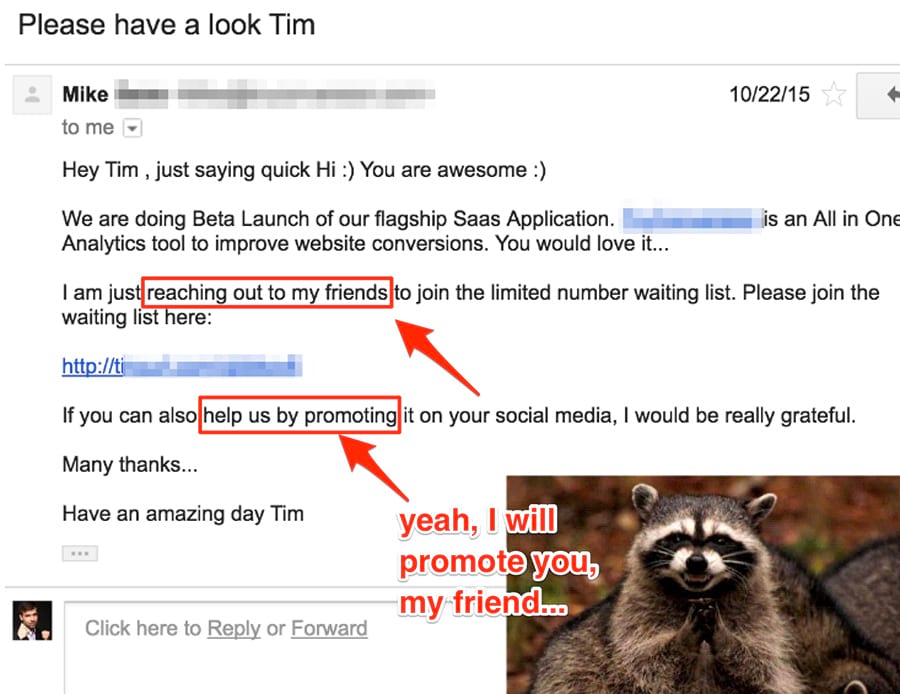
Don’t be that guy.
Level up your outreach game
I sincerely hope this article makes you reconsider your outreach strategies.
Don’t shoot yourself in the foot. Be genuine and provide real value to the person you’re reaching out to.
There’s a human like you on the other side of the screen. Always remember that.
And should you get a bad outreach email in your inbox, just reply to them with a link to this post 😉






